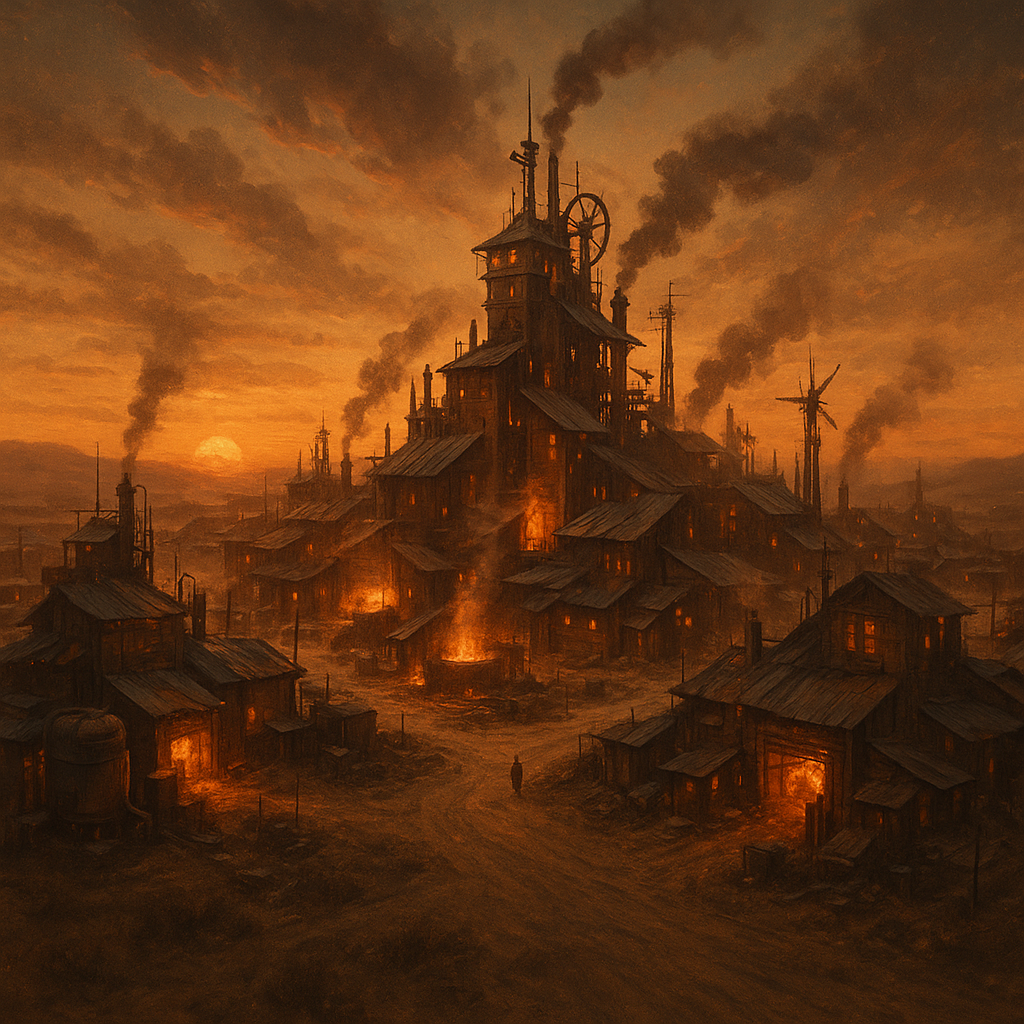
Nexa
-
Total Population: 42,781,390 registered citizens
-
High Enders: 18 percent — genetically optimized and economically privileged, concentrated in vertical housing above Sector Twelve
Midline Workers: 54 percent — engineers, Pulse technicians, service labor, and data architects
Low Enders: 27 percent — manual laborers, black-market traders, and citizens below Pulse stability threshold
Specters and Enforcers: 1 percent — government surveillance agents and private security operators
-
Average Tower Height: 420 floors
Power sourced from Pulse Grid: 98 percent
Public surveillance coverage: 99.9 percent
Average life expectancy within Pulse range: indefinite
-
Most visited district: The Neon District
Top export: Synthetic memory and cybernetic enhancement
Official motto: Eternity within reach

ORECREST
-
Population: 1,340 permanent residents, mostly families descended from the original miners and a few traveling tradespeople.
-
Miners, blacksmiths, and stonecutters who’ve shifted from extraction to repair and trade. Life revolves around endurance and resourcefulness rather than ambition.
-
A compact settlement nestled at the base of the mountain range, built from stone and repurposed mining steel. The old tunnels and shafts remain sealed or converted into cold storage and workshops. Power comes from small wind rotors and water flow from nearby streams.
-
Orecrest endures a cold, dry climate shaped by its mountain proximity. Winds carry fine dust from old quarry slopes, while low fog drifts through the valley most mornings. Rain is rare, but runoff from the cliffs feeds small streams that cut through the rocky ground. Nights are long and biting, and the faint echo of shifting stone reminds the villagers the mountain is never truly still.
-
Orecrest lives quietly, holding to tradition. Its people value labor, loyalty, and the preservation of what’s left. Among all settlements, it’s seen as the last true remnant of the world that once built Nexa.

Edenridge
-
Population: 612 permanent residents, with fewer than 50 travelers passing through each season.
-
A resilient mix of farmers, craftspeople, and former Nexans who abandoned the Pulse to live by hand and heart.
-
Simple wooden homes and solar-turbine hybrids nestled between forest and river, fully independent from the Pulse Grid.
-
Revered for its shared labor, candlelit gatherings, and belief that life’s worth is measured by connection, not circuitry.

Lakenbridge
-
Population: 972 permanent residents, with a slow trickle of travelers seeking passage across the lake.
-
Welders, builders, scavengers, and drifters who maintain the bridge as both shelter and lifeline, surviving without Pulse support.
-
Reinforced steel platforms suspended over deep water, powered by wind rotors and makeshift hydroturbines, with compact housing and shared resource stations.
-
Known for its self-reliance, bridge markets, and strict entry laws, Lakenbridge endures as a testament to survival on the edge of nowhere.

The Pit
-
Population: Estimated between 4,000 and 6,000 at any given time. Numbers fluctuate as prisoners die, vanish, or are quietly replaced.
-
Convicts, scavengers, and outcasts sentenced to permanent isolation. Few last more than a few years, and those who do often become something unrecognizable.
-
The Pit sprawls within a colossal crater beneath a humming electric dome that crackles purple against the desert sky. The charged haze distorts the air, painting everything in violet light and restless static.
-
The ground is scorched metal and baked sand. Winds whip dust into choking spirals. The heat warps steel, the nights freeze bone, and the hum of the dome never fades.
Infrastructure Data: Rusted rigs serve as shelters, broken lifts act as trading posts, and scavenged machinery is refitted into weapons, tools, or symbols of power. Water is scarce, power is currency, and food comes from whatever can still move. -
Within the dome there are no laws, only the shifting rule of strength and desperation. The Pit breathes like a living organism, feeding on fear and violence, sustained by the belief that escape is impossible.

CINDERFALL
-
Population: 21,460 permanent residents, with an additional 3,000 seasonal laborers and traders moving through during peak production months.
-
A working-class population of machinists, salvagers, traders, and blacksmiths. Most are independent contractors bound by trade networks with Nexa, though a growing number operate outside Council oversight.
-
Built around the remnants of an old Pulse line, Cinderfall runs on scavenged reactors and converted fuel systems. Smelting pits, forges, and repair bays form its industrial core, surrounded by layered housing, markets, and storage yards. The town’s perimeter is marked by wind towers and rusted cranes that creak against the dry winds.
-
Constant dust storms, searing daylight, and frigid nights. The air carries the scent of ash and iron, and visibility often drops when the winds shift from the plains.
-
Known as the settlement that never truly sleeps, Cinderfall thrives on resilience and invention. Its people live by the mantra if it breaks, rebuild it. Forged in heat and dust, the city endures as the frontier’s mechanical heartbeat.

Wildlands
-
Estimated Inhabitants: Fewer than 60 permanent settlers scattered across remote cabins and caves; transient hunters and fugitives rarely recorded.
-
A vast mountain chain dividing Nexa’s controlled territory from the eastern frontier. Peaks rise beyond cloud height, cut by deep valleys, sheer cliffs, and hidden passes that shift with the seasons. Environmental Conditions: Harsh and unpredictable weather marked by freezing winds, sudden rockslides, and violent storms. Vegetation clings to the lower slopes, while the upper ranges remain barren and treacherous.
-
only remnants of old roadways
-
The Wildlands are seen as both a frontier and a warning—a place where those seeking freedom vanish into silence, leaving only their stories behind.